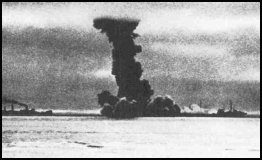 German sapper lays mine at el Alamein |
Project 60: A Day-by-Day Diary of WWII
Remembering the First Fight Against Fascism |
 Convoy PQ-17 under attack |
 German sapper lays mine at el Alamein |
Project 60: A Day-by-Day Diary of WWII
Remembering the First Fight Against Fascism |
 Convoy PQ-17 under attack |
June 30, 1942 The Soviets, running
our of ammunition, food, water, and space, begin the evacuation of Sevastopol. The vanguard of
Rommel's forces, exhausted, low on fuel and water, reach the British lines at
El Alamein. July 1, 1942 An American submarine
operating off Luzon, sinks a Japanese transport. Unknown to the boat's
skipper, the ship was carrying Australian POWs. 849 drowned. Sevastopol falls to
the Germans. 24 days of siege end in a costly victory for the Germans. 97,000
Soviet soldiers and sailors are captured. Hitler promoted the victorious
commander, von Manstein to Field Marshal. German forces in
Yugoslavia launch major attacks in the Kozara region against Tito's partisans. Rommel makes one last attempt to break the British lines at El Alamein, losing 13 of his last 26 tanks. By the end of the day, he suspends offensive operations and sets the troops to building defensive positions. The First Battle of El Alamein had ended in British victory. Egypt was saved. July 4, 1942 Convoy PQ17,
consisting of 35 merchants, 6 destroyers and 15 other escorts, en route to
Archangel, comes under heavy air attack. Four of the vessels are sunk. Reports
indicate that the German surface fleet, including the battleship Tirpitz,
have left their anchorages in Norway and are heading in to kill the convoy. The
convoy is ordered to scatter to avoid the confrontation with the superior German
surface force. Six B-17 from the
newly activated US 8th Air Force join RAF bombers in hitting German
airfields in Holland. July 5, 1942 With news of the
scattered convoy and the threat of losses, Hitler orders the surface fleet back
to Norway. Air attacks, however, continue and intensify. Ultimately, only 11
merchants would make it to Archangel. 99,316 tons of material, including 430
tanks and 210 aircraft were lost. Elements of 4th
Panzer Army reach Voronezh on the Don River. July 6, 1942 QP13, while returning
from Russia makes a navigational error off Iceland, putting the convoy into a
British minefield. Five merchants sunk before the group maneuvered to safety. The Germans commence
operation Swampflower against Russian partisan forces in the Dorogobuzh area. U-132, commanded by Capt. Vogelsang, enters the St. Lawrence seaway and sinks 3 merchant ships.
Soviet forces counter-attack the German
6th Army at Voronezh, succeeding in stopping the German attacks in
the area, but not driving them back. 4th Panzer
Army attacks southeast of Voronezh along the west bank of the Don River as the
retreating Soviet forces abandon Starii Oskol. Hitler changes the plans for the summer offensive, directing Army Group A to Rostov and the Caucusus Mountains, while Army Group B marched on Stalingrad. The plane to destroy the southern wing of the Red Army in open battle had been abandoned to Hitler's desire to occupy land. After days of
deceptive movements of his forces, General Auchinleck goes on the offensive.
Rommel, lured south by planned withdraws, strikes into empty ground. Meanwhile,
the British XXX Corp hits the Italians along the coast road. The attacks routed
the Italian Sabratha Division and threatened Rommel's HQ and supply lines. Rommel calls off his
errant attack in the south and returns to his defensive positions. Panzer Army
Afrika, battered and a few miles back restores the situation at El Alamein.
Rommel lets it be known that he no longer has confidence in the Italian forces
under his command and begins deploying elements of the 164th Infantry
division with the Italians as "stiffeners". As his southern front
crumbles, Stalin moves massive numbers of troops into the Stalingrad area,
forming a new Front (Army Group) under Marshal Timoshenko. After two weeks of
heavy fighting, German forces in Army Group North succeed in eliminating the
Vlasov's 2nd Shock Army in the Volkhov area, taking 30,000
prisoners. Vlasov would later turn on his former comrades and support the Nazis
by leading the anti-Bolshevik Russian Liberation Army. Rommel attacks
British positions beyond the Ruweisat ("Kidney") Ridge south of El Alamein.
His forces are bloodily repulsed. 1941 Archive: 1942 Archive: Special Editions: Editor's Corner Archive: The Past Through Tomorrow "It is quite frightening to realize just how similar our nation's actions have been and appear to be heading when compared this way..." Afghanistan and Vietnam: When the "war against terrorism" began, many knowledgeable people warned that our operations in Afghanistan would turn into another Vietnam. Want to Win - Think Before You Lash Out - "If we are serious about taking the war to the enemy, it is time to look ..." The First Fight Against Fascism - We must remember the Spanish Civil War also. Arguing Victory - "... Each nation who fought against fascist tyranny in WWII brought with it part of whole needed to defeat that evil..." War, Glory, Honor and Remembrance - "War is a brutal and savage insult on human society..." The
First Casualty... in time of war, those in power are even more inclined to hide the truth,
since that truth is often manifest in the most gruesome and terrible
acts. Those wishing to contribute items. stories or comments should contact D.A. Friedrichs |